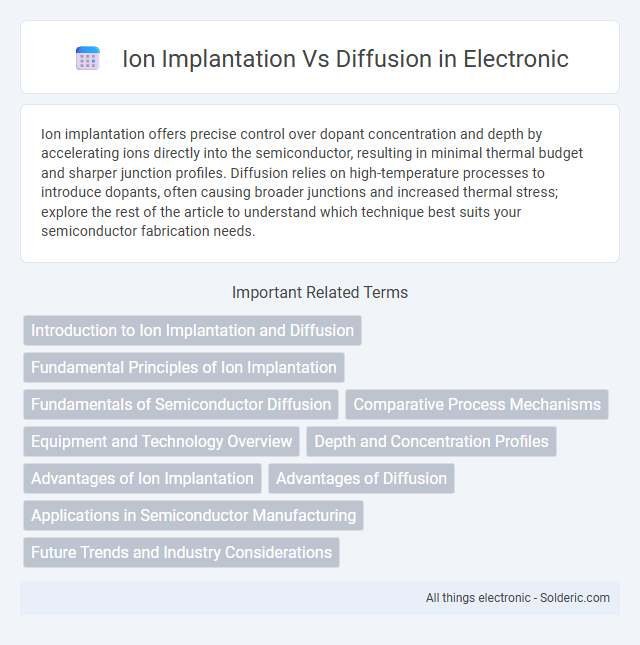Ion implantation offers precise control over dopant concentration and depth by accelerating ions directly into the semiconductor, resulting in minimal thermal budget and sharper junction profiles. Diffusion relies on high-temperature processes to introduce dopants, often causing broader junctions and increased thermal stress; explore the rest of the article to understand which technique best suits your semiconductor fabrication needs.
Comparison Table
| Aspect | Ion Implantation | Diffusion |
|---|---|---|
| Process | Accelerated ions injected into substrate | Atom migration driven by temperature gradient |
| Temperature | Low to moderate (room temp to 1000degC) | High (900degC to 1200degC) |
| Depth Control | Precise, nanometer scale depth control | Less precise, micrometer scale diffusion depth |
| Doping Concentration | Highly controllable, uniform profiles | Concentration gradient, less uniform |
| Damage to Substrate | Potential lattice damage, requires annealing | No lattice damage |
| Process Speed | Fast | Relatively slow |
| Equipment Complexity | High, requires ion implanters | Low, uses furnaces |
| Applications | Advanced semiconductor doping, shallow junctions | Bulk doping, gate oxidation processes |
Introduction to Ion Implantation and Diffusion
Ion implantation and diffusion are key techniques in semiconductor fabrication used to introduce dopants into silicon wafers. Ion implantation involves accelerating ions to high energies and embedding them precisely into the substrate, allowing for controlled doping profiles critical in modern microelectronics. Diffusion, by contrast, relies on thermal energy to drive dopants from a source into the silicon, resulting in broader concentration gradients and less precise control over placement.
Fundamental Principles of Ion Implantation
Ion implantation precisely embeds ions into a semiconductor substrate by accelerating charged particles electrically, allowing for controlled doping profiles and depths unattainable by diffusion processes. This technique relies on high-energy ion beams directed into the target material, creating localized modifications in electrical properties without requiring high temperatures. Your semiconductor fabrication benefits from ion implantation's superior accuracy, enabling enhanced device performance and scaling in integrated circuits.
Fundamentals of Semiconductor Diffusion
Semiconductor diffusion involves the movement of dopant atoms from high to low concentration regions within the crystal lattice, driven by thermal energy and concentration gradients. Ion implantation, in contrast, introduces dopants by bombarding the substrate with high-energy ions, enabling precise control over dopant profiles without requiring high-temperature processing. Understanding the atomic mechanisms of diffusion, such as interstitial and vacancy-mediated migration, is critical for optimizing dopant activation and minimizing defects in semiconductor fabrication.
Comparative Process Mechanisms
Ion implantation involves accelerating ions directly into the semiconductor substrate, enabling precise control over dopant placement and concentration, while diffusion relies on high-temperature processes that cause dopants to spread from a gas or solid source into the substrate. Ion implantation provides better depth control and minimal thermal budget impact compared to diffusion, which can cause broader dopant profiles and more thermal stress. Your choice between these processes depends on the required dopant distribution accuracy and thermal budget constraints in semiconductor fabrication.
Equipment and Technology Overview
Ion implantation utilizes advanced particle accelerators to embed ions into semiconductor substrates with precise control over depth and concentration, making it ideal for shallow junction formation in microelectronics. Diffusion equipment involves high-temperature furnaces where dopant atoms diffuse into silicon wafers through gas or solid sources, resulting in deeper junctions but less control over abruptness compared to ion implantation. Your choice between these technologies depends on the required doping profiles, process integration, and device performance specifications.
Depth and Concentration Profiles
Ion implantation offers precise control over dopant depth and concentration profiles, enabling shallow and abrupt junctions critical for advanced semiconductor devices. Diffusion produces more gradual concentration gradients with deeper and less precisely defined dopant penetration, influenced by temperature and time variables. Your choice between ion implantation and diffusion impacts device performance by dictating the semiconductor's electrical characteristics at specific depths.
Advantages of Ion Implantation
Ion implantation offers precise control over dopant concentration and depth, enabling sharp dopant profiles essential for advanced semiconductor devices. It produces minimal contamination and allows for low-temperature processing, reducing thermal damage to substrates. This technique also supports high throughput and repeatability, making it ideal for large-scale integrated circuit manufacturing.
Advantages of Diffusion
Diffusion offers advantages such as simplicity and cost-effectiveness compared to ion implantation, making it ideal for large-scale semiconductor manufacturing. This process allows for uniform dopant distribution and deeper junction formation, which is beneficial for certain device applications. Your production can benefit from diffusion's high throughput and compatibility with existing thermal processes.
Applications in Semiconductor Manufacturing
Ion implantation offers precise doping control and depth profiling essential for advanced semiconductor devices, enabling ultra-shallow junctions in CMOS technology and high-dose implants for power devices. Diffusion remains crucial for forming uniform dopant profiles over larger areas, widely used in well formation and gate oxidation processes. Your choice between ion implantation and diffusion impacts device performance, scalability, and fabrication complexity within semiconductor manufacturing.
Future Trends and Industry Considerations
Ion implantation is expected to dominate future semiconductor fabrication due to its precise control over dopant profiles and low thermal budgets, making it ideal for advanced node scaling and 3D device architectures. Diffusion processes, while cost-effective and simpler, face limitations in achieving ultra-shallow junctions required for next-generation transistors, prompting industry shifts toward ion implantation or hybrid techniques. Emerging trends emphasize integrating ion implantation with novel annealing methods, such as laser or flash annealing, to enhance dopant activation and minimize defects, addressing industry demands for higher performance and lower power consumption.
Ion Implantation vs Diffusion Infographic

 solderic.com
solderic.com